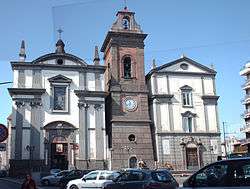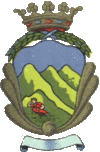Giugliano in Campania
| Giugliano in Campania | ||
|---|---|---|
| Comune | ||
| Comune di Giugliano in Campania | ||
|
Church of the Annunziata. | ||
| ||
.svg.png) | ||
 Giugliano in Campania Location of Giugliano in Campania in Italy | ||
| Coordinates: 40°56′N 14°12′E / 40.933°N 14.200°ECoordinates: 40°56′N 14°12′E / 40.933°N 14.200°E | ||
| Country | Italy | |
| Region | Campania | |
| Province / Metropolitan city | Metropolitan City of Naples | |
| Frazioni | Lago Patria | |
| Government | ||
| • Mayor | Antonio Poziello | |
| Area | ||
| • Total | 94 km2 (36 sq mi) | |
| Population (29 February 2016) | ||
| • Total | 123,174 | |
| • Density | 1,300/km2 (3,400/sq mi) | |
| Demonym(s) | Giuglianesi | |
| Time zone | CET (UTC+1) | |
| • Summer (DST) | CEST (UTC+2) | |
| Postal code | 80014 | |
| Dialing code | 081 | |
| Patron saint | St. Iulianus | |
| Saint day | January 9 | |
| Website | Official website | |
Giugliano in Campania [dʒuʎˈʎjaːno in kamˈpaːnja], also known simply as Giugliano, is a city and comune in the Metropolitan City of Naples, Campania, Italy. As of 2016, it had some 123,000 inhabitants, making it the most populated Italian city that is not a provincial capital.
Geography
It is located in a fertile coastal plain north of Naples, thus serving as a market for agricultural products to the city. The plain on which it sits was known in ancient Roman times as the Campania Felix.
History
In 5th-4th century BCE the territory of Giugliano was settled by the Osci. According to a tradition, the city was founded by a group of colonists from Cuma in 421 BCE, who called it Lilianum ("Land of the lilies"). The city remained a small center until 1207, when Cuma was destroyed by the Neapolitans; some of the citizens from that town, including the clergy and the cathedral capitular, took shelter in Giugliano. The first documents mentioning a fief in Giugliano dates from 1270.
Lords of the city were, in sequence, the Vulcano, Filomarino, Pignatelli, D'Aquino, Pinelli and Colonna.
Main sights
- Palazzo Pinelli, built in 1545 by architect Giovanni Francesco di Palma. It had a side tower, which was later demolished.
- Church of Santa Sofia (17th century), designed by Domenico Fontana. It was finished in 1730-1745 by the Neapolitan architect Domenico Antonio Vaccaro. It houses the tomb of Giovan Battista Basile.
- Church of the Annunziata, known from the 16th century. It is home to several canvasses by Neapolitan artists such as Massimo Stanzione and Carlo Sellitto. it has a nave with apse and transept; the pulpit is in Roccoco style, while the rest of the interior is decorated in Baroque style. Notable are also the large wooden organ (late 16th century), the Chapel of Madonna della Pace and early 16th Stories of the Virgin' in the left transept.
- Church of Sant'Anna. Of the original building, existing in the 14th century, the bell tower remains. It houses 16th-century paintings by Fabrizio Santafede and Pietro Negroni.
- Church of Madonna delle Grazie, with a 14th-century bell tower and a 16th-century portal. The interior has a 15th-century Gothic Incoronation of the Virgin and early 16th-century frescoes.
Transportation
Giugliano is served by Naples–Aversa railway, a railway suburban train connection to the Naples Metro.
Famous people
- Giovan Battista Basile, poet, courtier, and fairy tale collector
- Scipio Africanus, Roman general
- Adriana Basile, composer and singer
- Raffaele Cantone, magistrate
- Nicola Mignogna, politician and a significant contributor of “Risorgimento”
Neighboring communes
Giugliano in Campania borders the following municipalities: Aversa, Casapesenna, Castel Volturno, Lusciano, Melito di Napoli, Mugnano di Napoli, Parete, Pozzuoli, Qualiano, Quarto, San Cipriano d'Aversa, Sant'Antimo, Trentola-Ducenta, Villa Literno, Villaricca.
See also
External links
![]() Media related to Giugliano in Campania at Wikimedia Commons
Media related to Giugliano in Campania at Wikimedia Commons

